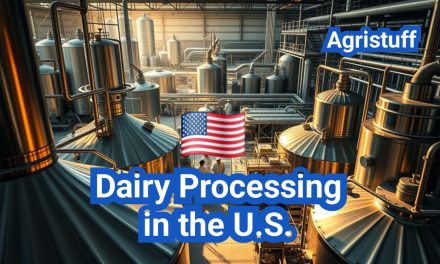Unsweetened condensed milk is a type of cow’s milk from which water has been removed, resulting in a rich, creamy texture. Unlike sweetened condensed milk, this version is sterilized, giving it a long shelf life without the need for refrigeration until opened.
The processing of unsweetened condensed milk involves removing water from cow’s milk, followed by sterilization. This process differs significantly from that of sweetened condensed milk, which has added sugars. Understanding the differences between these products, as well as evaporated milk, is crucial for choosing the right ingredient for your recipes.
Key Takeaways
- Unsweetened condensed milk is made by removing water from cow’s milk and then sterilizing it.
- It has a long shelf life and doesn’t require refrigeration until opened.
- The absence of added sugar distinguishes it from sweetened condensed milk.
- Evaporated milk and unsweetened condensed milk share some similarities but are used differently in recipes.
- Understanding the nutritional aspects of unsweetened condensed milk is essential for its use.
What Is Unsweetened Condensed Milk?
Unsweetened condensed milk, a product often confused with its sweetened counterpart, has a unique processing method and history. It is made by removing water from milk and then sterilizing it, resulting in a creamy, rich dairy product.
Definition and Basic Characteristics
Unsweetened condensed milk is defined by its process: milk is heated under vacuum to remove a significant portion of its water content, and then it is sterilized. This process gives the milk a thick, creamy consistency without adding any sugar. The result is a versatile ingredient used in both savory and sweet dishes. Its basic characteristics include a high protein content and a rich, creamy texture, making it a valuable addition to various recipes.
Historical Background of Condensed Milk
The history of condensed milk dates back to the 19th century when it was first developed by Nicolas Appert, a French chef and confectioner, in response to a need for preserved food for the military. Later, Gail Borden improved upon this process in the United States, developing a method for condensing milk that was both practical and commercially viable. The product quickly gained popularity for its long shelf life and versatility in cooking.
Throughout its history, condensed milk has been a staple in many cuisines, particularly in regions where fresh milk was scarce. Its evolution over time has led to the development of both sweetened and unsweetened varieties, each with its unique applications in cooking and baking.
Understanding the Difference: Sweetened vs. Unsweetened Condensed Milk

Understanding the differences between sweetened and unsweetened condensed milk can elevate your culinary creations. While both types of condensed milk are derived from milk, their distinct characteristics set them apart in terms of usage, taste, and texture.
Key Differences in Composition
The primary distinction between sweetened and unsweetened condensed milk lies in their composition. Sweetened condensed milk contains a significant amount of added sugar, which not only enhances its flavor but also contributes to its thicker consistency. On the other hand, unsweetened condensed milk, also known as evaporated milk, is sterilized and has no added sugar, resulting in a product that is less sweet and has a different texture.
The process of making these two types of condensed milk also differs. Sweetened condensed milk is made by heating milk to remove a significant portion of its water content and then adding sugar to it. In contrast, unsweetened condensed milk is made by heating milk to remove water, then sterilizing it, usually through ultra-high temperature (UHT) processing, without adding any sugar.
Taste and Texture Comparison
The taste and texture of sweetened and unsweetened condensed milk are markedly different due to their distinct compositions. Sweetened condensed milk is characterized by its rich, sweet flavor and thick, creamy texture, making it ideal for desserts and sweet dishes. Conversely, unsweetened condensed milk has a more neutral taste and a thinner consistency compared to its sweetened counterpart, making it suitable for both savory and sweet recipes.
In cooking and baking, the choice between sweetened and unsweetened condensed milk depends on the desired outcome. For instance, unsweetened condensed milk is often used in savory dishes or as a creamer in coffee, while sweetened condensed milk is a staple in desserts like cheesecakes and custards.
Unsweetened Condensed Milk vs. Evaporated Milk: Are They the Same?
Unsweetened condensed milk and evaporated milk are often confused with each other, but they have distinct differences in terms of processing and usage. Both products are made by removing water from milk, but the process and the final product characteristics differ significantly.
Terminology Clarification in the Dairy Industry
The dairy industry uses specific terminology to differentiate between various milk products. Unsweetened condensed milk is often referred to as evaporated milk in some contexts, but technically, unsweetened condensed milk is sterilized and has a different consistency and usage compared to evaporated milk. Understanding these terms is crucial for both consumers and manufacturers.
The process of making unsweetened condensed milk involves sterilization, which extends its shelf life and gives it a distinct characteristic. On the other hand, evaporated milk is not sterilized in the same way and has a different fat content, making it more suitable for certain recipes.
Industry Standards and Labeling Practices
Industry standards and labeling practices play a significant role in how these products are perceived by consumers. Manufacturers must adhere to specific guidelines when labeling their products as unsweetened condensed milk or evaporated milk. These guidelines ensure that consumers are not misled and can make informed decisions.
Labeling practices also involve disclosing the ingredients, nutritional content, and any additives used in the products. This transparency is essential for consumers who have dietary restrictions or preferences. By understanding the labeling, consumers can better differentiate between unsweetened condensed milk and evaporated milk.
The Processing of Unsweetened Condensed Milk

To produce unsweetened condensed milk, manufacturers follow a detailed process that includes standardization, heat treatment, and sterilization. This process is crucial for achieving the desired consistency and shelf life of the final product.
Manufacturing Process Step-by-Step
The manufacturing process begins with the standardization of milk, where the fat content is adjusted to meet the required specifications. This is followed by heat treatment, which involves heating the milk to a high temperature to kill off bacteria and extend its shelf life.
The next step is evaporation, where the milk is heated under vacuum to remove excess water, resulting in a concentrated product. This process is carefully controlled to prevent the milk from scorching or developing an off-flavor.
After evaporation, the condensed milk undergoes homogenization, a process that ensures the fat molecules are evenly distributed, giving the milk a uniform texture. Finally, the product is sterilized through ultra-high temperature (UHT) processing or retorting to ensure it is commercially sterile.
| Process Step | Description | Purpose |
|---|---|---|
| Standardization | Adjusting fat content | Meet specifications |
| Heat Treatment | Heating to high temperature | Kill bacteria, extend shelf life |
| Evaporation | Removing excess water | Concentrate the milk |
| Homogenization | Distributing fat molecules evenly | Uniform texture |
| Sterilization | UHT processing or retorting | Ensure commercial sterility |
Modern Production Techniques and Quality Control
Modern dairy processing plants employ advanced technologies to ensure the production of high-quality unsweetened condensed milk. These include sophisticated pasteurization and sterilization techniques, as well as rigorous quality control measures at every stage of production.
Quality control involves regular testing for microbial contamination, fat content, and other parameters to ensure the product meets the required standards. Manufacturers also adhere to strict sanitation and hygiene practices to prevent contamination and ensure the product’s safety and quality.
Nutritional Profile of Unsweetened Condensed Milk
The nutritional profile of unsweetened condensed milk reveals its value as a rich source of calories, proteins, and various micronutrients. This dairy product is created by removing a significant portion of water from milk, resulting in a concentrated form that is rich in nutrients.
Caloric Content and Macronutrients
Unsweetened condensed milk is high in calories, primarily due to its fat content. A single cup of unsweetened condensed milk contains approximately 600 calories, with a significant portion coming from its high fat content. It is also a good source of protein, containing about 16 grams per cup. The carbohydrate content is relatively low compared to sweetened versions, making it a favorable option for those monitoring their sugar intake.
The macronutrient breakdown of unsweetened condensed milk includes a high percentage of fat, a moderate amount of protein, and a relatively low carbohydrate content. This composition makes it an excellent addition to recipes requiring rich, creamy textures without the added sugar.
Vitamins and Minerals Present
Unsweetened condensed milk is not only a good source of macronutrients but also rich in various vitamins and minerals. It contains significant amounts of calcium, phosphorus, and potassium, which are crucial for bone health and other bodily functions. Additionally, it is a good source of vitamins B12 and B2 (riboflavin), contributing to its nutritional value.
The presence of these vitamins and minerals enhances the nutritional profile of unsweetened condensed milk, making it a valuable ingredient in both sweet and savory dishes. Its nutrient-dense nature supports its use in a variety of culinary applications, from desserts to sauces and soups.
Evaporated Milk Nutrition: A Detailed Breakdown
Delving into the nutritional aspects of evaporated milk reveals its potential health benefits and considerations. Evaporated milk, known for its rich and creamy texture, is a popular ingredient in many recipes. But what makes it nutritionally significant?
Nutritional Comparison with Regular Milk
Evaporated milk has a similar nutritional profile to regular milk but with some key differences due to its processing. The removal of water content concentrates the nutrients, making it a dense source of calories, proteins, and minerals.
| Nutrient | Evaporated Milk (per cup) | Regular Milk (per cup) |
|---|---|---|
| Calories | 338 | 170 |
| Protein | 17g | 8g |
| Calcium | 870mg | 300mg |
As shown, evaporated milk contains more calories, protein, and calcium compared to regular milk, making it a nutrient-dense option.
Health Benefits and Dietary Considerations
The high protein and calcium content in evaporated milk can contribute to bone health and muscle repair. However, its high calorie density means it should be consumed in moderation, especially by those monitoring their calorie intake.
Key Health Benefits:
- Rich in protein for muscle health
- High in calcium for bone health
- Can be a nutritious addition to diets when consumed in moderation
In conclusion, evaporated milk offers a unique nutritional profile that can be beneficial when incorporated thoughtfully into one’s diet.
Shelf Life and Storage Guidelines for Unsweetened Condensed Milk

To keep unsweetened condensed milk fresh for as long as possible, it’s essential to follow the right storage guidelines. Proper storage not only extends its shelf life but also maintains its quality and safety for consumption.
Unopened Storage Recommendations
Unopened cans of unsweetened condensed milk can be stored in a cool, dry place, away from direct sunlight and heat sources. The ideal storage temperature is between 50°F to 70°F (10°C to 21°C). Under these conditions, the cans can last for up to 12 months or more, depending on the manufacturer’s guidelines. It’s crucial to check the expiration date on the can before storing.
After Opening: Proper Handling and Refrigeration
Once opened, unsweetened condensed milk should be transferred to an airtight container and refrigerated promptly. The container should be clean and dry to prevent contamination. Refrigerated unsweetened condensed milk should be consumed within 3 to 5 days. It’s also important to check for any signs of spoilage before consumption, such as an off smell or curdling.
Signs of Spoilage to Watch For
Before using unsweetened condensed milk, always inspect it for signs of spoilage. These include:
- An off or sour smell
- Curdling or separation
- Mold or yeast growth
- Slime or bubbles in the container
If you notice any of these signs, it’s best to discard the product to avoid foodborne illness.
How to Use Unsweetened Condensed Milk in Cooking

Cooking with unsweetened condensed milk opens up a world of culinary possibilities. This versatile ingredient can be used to enrich both savory and sweet dishes, making it a valuable addition to any kitchen.
Unsweetened condensed milk is made by evaporating milk to remove a significant portion of its water content, resulting in a rich, creamy texture. Unlike its sweetened counterpart, unsweetened condensed milk doesn’t contain added sugars, making it a preferred choice for those looking to control the sweetness level in their recipes.
Savory Applications and Techniques
In savory cooking, unsweetened condensed milk can be used to add depth and richness to sauces, soups, and curries. For instance, it can be used in creamy pasta sauces or as a base for rich and creamy soups. When cooking with unsweetened condensed milk in savory dishes, it’s essential to balance its richness with other flavors.
- Use it as a base for creamy soups and sauces.
- Add it to curries for an extra layer of flavor.
- Mix it with herbs and spices to create a marinade for meats.
| Savory Dish | Usage of Unsweetened Condensed Milk |
|---|---|
| Creamy Pasta Sauce | Mix with garlic, herbs, and parmesan for a rich sauce. |
| Thai Curries | Add to coconut milk-based curries for enhanced creaminess. |
Sweet Applications and Baking Tips
In baking and sweet recipes, unsweetened condensed milk can be a game-changer. It adds moisture and a rich, creamy texture to desserts. When using it in sweet dishes, you can control the amount of sugar added, allowing for a more balanced flavor.
“The use of unsweetened condensed milk in desserts like cheesecakes and custards can elevate them to a new level of creaminess and flavor.” –
A renowned pastry chef
Some sweet applications include:
- Using it in cheesecakes and custards for a creamy texture.
- Adding it to ice cream for a richer flavor.
- Incorporating it into cakes and muffins for added moisture.
By understanding how to use unsweetened condensed milk effectively, home cooks and bakers can expand their culinary repertoire and create dishes that are both delicious and sophisticated.
Popular Recipes Using Unsweetened Condensed Milk

Unsweetened condensed milk is a versatile ingredient that can elevate both sweet and savory dishes. Its rich texture and subtle flavor make it an ideal addition to a variety of recipes.
Dessert Recipes with Detailed Instructions
Unsweetened condensed milk is a key ingredient in many desserts, adding creaminess and depth to traditional sweets. For example, a classic creme brûlée recipe can be made by combining unsweetened condensed milk with eggs, sugar, and vanilla, then baking until set. The result is a rich, creamy dessert with a caramelized sugar crust.
Another popular dessert is tres leches cake, which incorporates unsweetened condensed milk along with evaporated milk and heavy cream to create a moist and flavorful cake.
- Creamy cheesecakes
- Rich ice cream
- Decadent puddings
Savory Dishes from Around the World
Unsweetened condensed milk is not limited to desserts; it also enhances savory dishes. In Thai cuisine, it’s used to make a creamy and slightly sweet curry sauce. By combining unsweetened condensed milk with curry paste, coconut milk, and spices, you can create a rich and aromatic sauce to serve with rice or noodles.
| Dish | Cuisine | Description |
|---|---|---|
| Curry Sauce | Thai | Creamy and slightly sweet sauce made with unsweetened condensed milk, curry paste, and coconut milk. |
| Mac and Cheese | American | A comforting pasta dish enriched with unsweetened condensed milk for extra creaminess. |
As demonstrated, unsweetened condensed milk is a versatile ingredient that can be used in a wide range of recipes, from sweet treats to savory meals.
Evaporated Milk vs. Cream: When to Use Each

Understanding the differences between evaporated milk and cream is crucial for achieving the desired outcome in cooking. Both are dairy products used to enhance the texture and flavor of various dishes, but they have distinct characteristics that make them suitable for different applications.
Cooking Applications Comparison Chart
To help clarify when to use evaporated milk versus cream, consider the following comparison chart:
| Application | Evaporated Milk | Cream |
|---|---|---|
| Soups and Sauces | Ideal for adding richness without excessive creaminess | Better for thick, creamy textures |
| Baking | Suitable for desserts where a subtle milk flavor is desired | Preferred for rich, creamy desserts like custards |
| Cooking | Good for savory dishes, curries, and casseroles | Excellent for dishes requiring a high fat content |
Taste, Texture, and Fat Content Differences
The primary differences between evaporated milk and cream lie in their fat content, taste, and texture. Evaporated milk has a lower fat content, typically around 6-9%, which makes it a lighter alternative for recipes where a subtle dairy flavor is desired. On the other hand, cream has a much higher fat content, usually between 36-40%, making it ideal for applications where richness and a creamy texture are paramount.
In terms of taste, evaporated milk has a more pronounced milk flavor, while cream is richer and can add a luxurious feel to dishes. The texture of evaporated milk is thinner and more pourable, whereas cream is thick and can be whipped to incorporate air, making it versatile for various culinary uses.
- Evaporated milk is great for soups, sauces, and baked goods where a lighter texture is desired.
- Cream is perfect for desserts, whipped toppings, and dishes that require a rich, creamy texture.
By understanding these differences, cooks can make informed decisions about when to use evaporated milk versus cream, ensuring their dishes turn out as intended.
How to Substitute Unsweetened Condensed Milk in Recipes

Whether you’re looking for dairy or non-dairy alternatives, substituting unsweetened condensed milk is easier than you think. Recipes often call for unsweetened condensed milk for its rich texture and dairy flavor, but dietary restrictions or ingredient availability might necessitate a substitute.
Understanding the role of unsweetened condensed milk in a recipe is crucial for selecting the right substitute. It adds moisture, tenderness, and a dairy-rich flavor. Substitutes should ideally offer similar characteristics.
Dairy Alternatives with Conversion Ratios
For those who still want to use dairy products, there are several alternatives. Evaporated milk is a direct substitute in many recipes, offering a similar consistency and dairy flavor. The conversion ratio is typically 1:1.
| Dairy Alternative | Conversion Ratio | Notes |
|---|---|---|
| Evaporated Milk | 1:1 | Similar consistency and flavor |
| Heavy Cream | 1:1 | Rich, creamy texture; may alter flavor slightly |
| Whole Milk | 1:1 (with adjustments) | Less creamy; may require thickening agent |
Non-Dairy and Vegan Substitution Options
For vegan or dairy-free diets, several non-dairy alternatives can substitute unsweetened condensed milk. Coconut cream, for instance, is a popular choice, offering a rich, creamy texture. The conversion ratio may vary depending on the desired consistency.
| Non-Dairy Alternative | Conversion Ratio | Notes |
|---|---|---|
| Coconut Cream | 1:1 (chilled) | Rich, creamy; distinct coconut flavor |
| Almond Milk Condensed | 1:1 | Requires sweetened and thickened version; nutty flavor |
| Cashew Cream | Varies | Blend soaked cashews with water; creamy texture |
When substituting unsweetened condensed milk, it’s essential to consider the flavor and texture the substitute will add to your recipe. Experimenting with different alternatives can help you find the perfect match for your culinary needs.
Step-by-Step Guide to Making Homemade Unsweetened Condensed Milk

Unsweetened condensed milk can be easily made at home using either a stovetop or a pressure cooker. This guide will walk you through both methods, allowing you to choose the one that best suits your needs.
Traditional Stovetop Method
The traditional stovetop method involves heating milk and letting it simmer until it reduces to the desired consistency. To start, you’ll need 2 cups of milk and a pinch of salt. Combine these in a saucepan and heat over medium heat, stirring occasionally, until the milk starts to simmer. Reduce the heat to low and let it cook for about 25-30 minutes, or until it has reduced by half and developed a rich, creamy texture.
Tips for the stovetop method: Stir frequently to prevent the milk from scorching, and adjust the heat as needed to maintain a gentle simmer.
Quick Pressure Cooker Method
For those short on time, the pressure cooker method is a faster alternative. Combine 2 cups of milk and a pinch of salt in the pressure cooker. Close the lid and set the valve to “sealing.” Cook on high pressure for 10-12 minutes, followed by a quick release. Let the mixture cool slightly before opening, as it will be very hot and may splatter.
The pressure cooker method significantly reduces cooking time while still producing a rich and creamy unsweetened condensed milk. “Making condensed milk at home is a game-changer for many recipes,” says a renowned chef. “It’s all about controlling the ingredients and the process.”
“The key to making great unsweetened condensed milk is patience and attention to detail.”
Both methods yield a high-quality unsweetened condensed milk that can be used in various recipes, from desserts to savory dishes. Experiment with different types of milk, such as almond or soy milk, to create dairy-free versions.
Unsweetened Condensed Milk in the U.S. Market
Major brands are now offering unsweetened condensed milk, catering to the U.S. market. This development reflects the growing demand for versatile dairy products that can be used in both sweet and savory dishes. The availability of unsweetened condensed milk in the U.S. market is a significant trend, driven by consumer preferences for less sweet and more flexible ingredients.
Major Brands and Product Availability
Several major brands have introduced unsweetened condensed milk to their product lines, making it widely available across the United States. Some of the prominent brands include Nestle, Borden, and Carnation. These brands offer their products in various retail channels, including online marketplaces, supermarkets, and specialty food stores.
Product Availability by Brand:
| Brand | Product Name | Availability |
|---|---|---|
| Nestle | Nestle Unsweetened Condensed Milk | Widely available online and in-store |
| Borden | Borden Unsweetened Condensed Milk | Available in major supermarkets |
| Carnation | Carnation Unsweetened Condensed Milk | Available online and in some stores |
Price Comparison and Purchasing Options
The prices of unsweetened condensed milk vary across brands and retailers. On average, a 14-ounce can costs between $2 and $4. Online retailers often offer competitive pricing and discounts for bulk purchases. Consumers can also find unsweetened condensed milk in specialty stores, though at potentially higher prices.
Price Comparison Across Retailers:
| Retailer | Price (14 oz can) |
|---|---|
| Amazon | $2.50 – $3.50 |
| Walmart | $2.00 – $3.00 |
| Whole Foods | $3.50 – $4.50 |
Consumers are advised to compare prices across different retailers to find the best deals. Additionally, purchasing from reputable sources ensures the quality and authenticity of the product.
Special Dietary Considerations
As consumers become more health-conscious, the scrutiny of unsweetened condensed milk’s suitability for special diets intensifies. This scrutiny is largely driven by concerns over lactose intolerance, dietary restrictions such as dairy-free requirements, and the growing demand for sugar-free and keto-friendly products.
Lactose Content and Dairy-Free Alternatives
Unsweetened condensed milk contains lactose, a sugar found in milk, making it unsuitable for those with lactose intolerance. For such individuals, dairy-free alternatives are available, often made from coconut milk, almond milk, or cashew cream. These alternatives can be used in similar applications, providing a comparable texture and richness to traditional unsweetened condensed milk.
Sugar-Free and Keto-Friendly Options
While unsweetened condensed milk is devoid of added sugars, its natural lactose content may still be a concern for those monitoring their sugar intake or following a keto diet. Sugar-free and keto-friendly versions of condensed milk can be made at home using sweeteners like stevia or erythritol and high-fat dairy or non-dairy bases. Commercially, some brands offer sugar-free condensed milk alternatives, catering to the dietary needs of health-conscious consumers.
In conclusion, while traditional unsweetened condensed milk may not be suitable for everyone due to its lactose content, there are viable alternatives and modifications that can be made to accommodate various dietary needs, including dairy-free, sugar-free, and keto-friendly options.
Understanding Ingredient Labels on Commercial Products
Commercial unsweetened condensed milk products vary widely in their ingredient lists, making label literacy essential. When shopping for these products, consumers are faced with a myriad of choices, each with its own set of ingredients and additives.
Understanding what’s on the label can help consumers make informed decisions about their dietary preferences and needs. The ingredient list can reveal a lot about the product’s quality, potential allergens, and nutritional content.
Common Ingredients and Additives to Know
Most unsweetened condensed milk products contain milk and sometimes salt. However, some may include additional ingredients such as stabilizers, thickeners, or flavor enhancers. Common additives include:
- Thickeners like carrageenan or guar gum to improve texture.
- Emulsifiers to prevent separation.
- Vitamins and minerals added for nutritional enhancement.
Being aware of these additives can help consumers choose products that align with their dietary preferences and restrictions.
Organic, Natural, and Specialty Options
For consumers seeking more natural or organic options, some brands offer products labeled as “organic” or “all-natural.” These products may appeal to those looking to avoid certain additives or preferring products with more straightforward ingredient lists.
Some key points to consider:
- Look for certifications like USDA Organic.
- Check the ingredient list for natural thickeners or stabilizers.
- Be mindful of the price, as specialty products can be more expensive.
By understanding these labels, consumers can make more informed choices that fit their needs and preferences.
The Versatility and Value of Unsweetened Condensed Milk
Unsweetened condensed milk has proven to be a versatile and valuable ingredient in various culinary applications. Its unique characteristics make it an ideal substitute in recipes, offering a rich and creamy texture without the added sugar.
The value of unsweetened condensed milk lies in its ability to enhance both sweet and savory dishes. From creamy soups to decadent desserts, this ingredient adds depth and complexity, making it a staple in many professional and home kitchens.
By understanding the processing, nutritional profile, and uses of unsweetened condensed milk, cooks can unlock its full potential. Whether you’re looking to substitute dairy products or create innovative recipes, unsweetened condensed milk is a valuable addition to any kitchen, showcasing its unsweetened condensed milk versatility and value.
FAQ
What is the difference between unsweetened condensed milk and sweetened condensed milk?
Unsweetened condensed milk is made by removing water from milk, resulting in a thick, creamy texture without added sugar. Sweetened condensed milk, on the other hand, has sugar added to it during the condensation process, making it sweeter and thicker.
Is unsweetened condensed milk the same as evaporated milk?
While both are made by removing water from milk, unsweetened condensed milk is thicker and creamier than evaporated milk. Evaporated milk is more diluted and has a lighter texture.
How is unsweetened condensed milk processed?
Unsweetened condensed milk is made by heating milk to remove excess water, then cooling and packaging it. The process involves pasteurization, evaporation, and homogenization to achieve the desired consistency.
What are the nutritional benefits of unsweetened condensed milk?
Unsweetened condensed milk is rich in calories, protein, and calcium. It is also a good source of vitamins and minerals like vitamin D, vitamin B12, and phosphorus.
Can I use unsweetened condensed milk as a substitute for evaporated milk?
Yes, but you may need to adjust the ratio and add water to achieve the desired consistency. Unsweetened condensed milk is thicker, so it’s best to start with a small substitution and adjust to taste.
How do I store unsweetened condensed milk?
Unopened cans of unsweetened condensed milk should be stored in a cool, dry place. Once opened, it should be refrigerated and consumed within a few days.
What are some common uses for unsweetened condensed milk?
Unsweetened condensed milk is versatile and can be used in both sweet and savory dishes, such as desserts, sauces, soups, and curries.
Can I make unsweetened condensed milk at home?
Yes, you can make unsweetened condensed milk at home by heating milk and reducing it until it reaches the desired consistency. You can use a stovetop or pressure cooker method.
Is unsweetened condensed milk lactose-free?
No, unsweetened condensed milk is not lactose-free. It is made from regular milk, which contains lactose. However, there are lactose-free and dairy-free alternatives available.
How do I read the ingredient label on commercial unsweetened condensed milk products?
When reading the ingredient label, look for additives like thickeners, stabilizers, or flavorings. Opt for products with minimal ingredients and no added sugars.
Can I use unsweetened condensed milk in keto or sugar-free diets?
Unsweetened condensed milk can be used in keto or sugar-free diets, but be mindful of its natural sugar content. You can also consider dairy-free or sugar-free alternatives.
What is the difference between evaporated milk and cream?
Evaporated milk is made by removing water from milk, resulting in a thinner consistency than cream. Cream, on the other hand, is the high-fat portion of milk, making it richer and thicker.
Conclusion of: Unsweetened Condensed Milk
Unsweetened Condensed Milk: the U.S. name, what it means
In U.S. grocery stores, unsweetened condensed milk is legally sold as evaporated milk—a shelf-stable dairy product made by removing water (and only water) from milk, then homogenizing and heat-sterilizing it in cans. If your recipe calls for unsweetened condensed milk, the can labeled “evaporated milk” is the correct match under the federal standard of identity. FDA standard of identity for evaporated milk.
How unsweetened condensed milk differs from sweetened condensed milk
Both products are concentrated milk, but unsweetened condensed milk contains no added sugar, while sweetened condensed milk is the same base milk plus enough nutritive carbohydrate sweetener to prevent spoilage, yielding a thick, dessert-ready syrup. For recipes, that means unsweetened condensed milk behaves more like concentrated dairy (good for sauces and soups), while sweetened condensed milk adds sugar and body for pies, bars, and candies. FDA standard of identity for sweetened condensed milk.
The core process: from fresh milk to unsweetened condensed milk
To make unsweetened condensed milk, processors start with clean, standardized milk, heat it to stabilize proteins, then remove ~60% of its water by evaporating under vacuum (a gentle boil at reduced pressure). The concentrate is homogenized to prevent fat separation, filled into cans, and commercially sterilized so it keeps safely at room temperature until opened. Codex Standard for Evaporated Milks (CXS 281-1971).
Commercial sterility and shelf stability
The final canning step gives unsweetened condensed milk its long pantry life: cans are processed to achieve “commercial sterility,” destroying pathogens and spoilage microbes. This retort/UHT step, combined with hermetic sealing, is why unopened cans store safely for months at room temperature when handled properly. Code of Hygienic Practice for Milk and Milk Products.
Composition and nutrition at a glance
Because water is removed, unsweetened condensed milk delivers more protein, calcium, and milk solids per cup than regular milk. U.S. law also requires vitamin D fortification, and some products add vitamin A; the concentrate is homogenized for a smooth, uniform body. If you’re comparing labels, you’ll notice higher “per serving” nutrients versus fluid milk due to concentration, not added sugar. 21 CFR §131.130 key composition & fortification.
Allowed ingredients in unsweetened condensed milk
Formulations of unsweetened condensed milk are tightly regulated: beyond milk, processors may add certain stabilizers (e.g., phosphates, carrageenan) to help prevent age gelation or protein precipitation through the can’s shelf life. Vitamins D (required) and sometimes A can be added; everything else must meet food-grade specifications. USDA AMS Commercial Item Description (Evaporated Milk, Shelf-Stable).
Fat levels and styles you’ll find
At retail, unsweetened condensed milk (evaporated milk) appears as regular/whole, reduced-fat, and fat-free versions. These styles meet the same core identity but differ in milkfat targets, letting you match richness to the dish (e.g., creamy chowders vs. lighter casseroles) while keeping the functionality of concentrated milk. USDA AMS classification of evaporated milk styles.
Kitchen uses: why chefs love it
In cooking, unsweetened condensed milk shines where creaminess and heat stability matter. It resists curdling in hot soups and sauces, enriches macaroni and cheese, and adds silky body to custards and puddings without extra sugar. It’s also handy in casseroles and cream pies when you want dairy richness with predictable results. University of Illinois Extension on evaporated vs. sweetened condensed.
Substituting for cream or half-and-half
For lighter results, many home economists swap unsweetened condensed milk for higher-fat dairy. If a recipe calls for half-and-half, undiluted evaporated milk is a classic stand-in; for some cream uses, fat-free evaporated milk offers body with less saturated fat (note: it won’t whip like cream). University of Illinois Extension substitution chart.
Reconstituting back to “regular milk”
When you need fluid milk and only have a can, you can dilute unsweetened condensed milk 1:1 with water to approximate whole milk for cooking and baking (flavor will differ slightly from fresh milk). This trick is great for emergency baking or pantry-first cooking. Oregon State (extension archive) on 1:1 dilution.
Storage: unopened, opened, and freezing guidance
Unopened cans of unsweetened condensed milk are shelf-stable (follow the “best by” date; store cool and dry). After opening, transfer leftovers to a clean, covered container, refrigerate, and use within about 4–5 days; freezing is possible for cooking use but can affect texture and appearance. FoodSafety.gov (FoodKeeper/Cold Storage) guidance.
Safety tips and can integrity
As with any canned food, unsweetened condensed milk in a swollen, leaking, severely dented, or rusted can should be discarded. If refrigeration is lost (e.g., extended outage) and an opened can warms into the “danger zone,” play it safe and toss it—quality and safety come first. FoodSafety.gov: power-outage discard list.
Lactose and milk-allergen note
Because it’s milk in concentrated form, unsweetened condensed milk still contains lactose and milk proteins. People with lactose intolerance may need to limit amounts or choose lactose-free alternatives; those with milk allergy must avoid it entirely and check labels carefully for allergen disclosures. NIH NIDDK: Lactose Intolerance—Definition & Facts.
Labeling: why your U.S. can doesn’t say “unsweetened condensed milk”
Don’t be confused by wording: U.S. law uses “evaporated milk” for unsweetened condensed milk, and “sweetened condensed milk” when sugar is added. If you want the unsweetened product, look for cans labeled simply “Evaporated Milk.” 21 CFR §1210.3 definitions (links to §131.130 and §131.120).
Processing details that affect performance
Gentle vacuum evaporation and proper homogenization help unsweetened condensed milk stay smooth in the can and creamy in recipes. Stabilizers allowed by standards help control age gelation and keep proteins calm during heating, so your sauces don’t break. Tetra Pak Dairy Processing Handbook (condensed/evaporated milk chapter).
Why many cooks prefer it for heat-based dishes
Because the proteins in unsweetened condensed milk are pre-stabilized and the water content is reduced, it’s less likely to curdle in hot, acidic, or salty environments compared with fresh milk. That’s why it’s a go-to for chowders, cream-style soups, and stovetop custards. University of Illinois Extension: functional advantages.
Using it in coffee, tea, and desserts
In beverages, unsweetened condensed milk adds a creamy mouthfeel without extra sugar—great for coffee, Thai-style tea variations (when sugar is added separately), and cocoa. In baking, it supplies dairy solids and fat that help browning and tenderness while letting you control sweetness by adding sugar to taste. Encyclopaedia Britannica: evaporated milk overview.
Nutrition strategy: richness without added sugar
For meal planning, unsweetened condensed milk can replace higher-fat cream in certain cooked applications, offering dairy nutrients with fewer calories from fat (especially if you choose fat-free evaporated milk). Remember, it’s concentrated; small amounts go a long way in sauces and casseroles. Mississippi State Extension: healthier substitutions.
Quick buyer’s guide
When buying unsweetened condensed milk, check: fat style (regular vs. fat-free), added vitamins (D is standard; A may be added), additives (stabilizers), and can integrity. Stock a couple of cans for pantry insurance—ideal for last-minute cream sauces, custards, or pies when fresh milk runs out. USDA AMS shelf-stable evaporated milk spec.
Unsweetened condensed milk vs. sweetened in recipes
Substituting unsweetened condensed milk for sweetened condensed milk will change sweetness, structure, and water activity; desserts that rely on the sugar-milk matrix (e.g., key lime pie, caramel bars) won’t set properly without added sugar. Always use the type your recipe specifies or adjust sugar and liquids deliberately. FDA: Sweetened condensed milk identity.
Allergen labeling and “non-dairy” confusion
Even though unsweetened condensed milk is straightforward milk, remember that “non-dairy” on some foods can still legally include milk derivatives like caseinates; rely on the ingredient list and allergen statement if you have milk allergy. Evaporated milk itself is a major allergen and is labeled as milk. FDA: Food Allergies & labeling.
Final thought
Once you know that unsweetened condensed milk equals “evaporated milk” in the U.S., it becomes a versatile pantry tool—concentrated dairy you can cook, dilute, or enrich with, all while keeping your ingredient list clean and your results reliable. Legal standard (21 CFR §131.130).
Sources & References
- 21 CFR §131.130 — Evaporated Milk (FDA)
- 21 CFR §131.120 — Sweetened Condensed Milk (FDA)
- 21 CFR §1210.3 — Definitions (links to standards)
- USDA AMS: Milk, Evaporated, Shelf-Stable (CID)
- USDA AMS: Evaporated Milk—Types/classes
- Codex Standard for Evaporated Milks (CXS 281-1971)
- Codex Code of Hygienic Practice for Milk & Milk Products
- Tetra Pak Dairy Processing Handbook — Condensed/Evaporated Milk
- FoodSafety.gov — Cold Food Storage Charts (FoodKeeper)
- FoodSafety.gov — Safety During Power Outage
- University of Illinois Extension — Evaporated vs Sweetened Condensed
- University of Illinois Extension — Recipe Substitutions
- Oregon State (extension archive) — 1:1 Dilution Guidance
- NIH NIDDK — Lactose Intolerance: Definition & Facts
- Encyclopaedia Britannica — Evaporated Milk Overview










